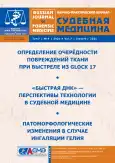On the classification and terminology of cadaveric phenomena
- Authors: Tkhakakhov A.A.1
-
Affiliations:
- Institute of Forensic Examinations and Criminalistics
- Issue: Vol 7, No 4 (2021)
- Pages: 45-50
- Section: Reviews
- URL: https://journals.rcsi.science/2411-8729/article/view/122434
- DOI: https://doi.org/10.17816/fm413
- ID: 122434
Cite item
Full Text
Abstract
The classification of cadaveric phenomena (post-mortal changes) generally accepted in scientific forensic medicine is outdated, is based on uncertain and incorrect principles (time and sequence of development), but throughout the long historical period in special literature is subject to practically unchanged and additions, contains contradictory and ambiguously interpreted definitions and terms, and therefore needs to be revision and revised.
The purpose of the review is to critically analyze and reveal the shortcomings and imperfections of the canonical classification and terminology of cadaveric phenomena, to develop a modern scientifically based classification of cadaveric phenomena, to clarify the terminology of some of them to reveal the shortcomings and imperfections of the canonical classification and terminology of cadaveric phenomena, to develop a modern scientifically based systematization of posthumous changes based on clear classification principles, to clarify and concretize the names of some of them.
The basic domestic textbooks for higher education institutions and manuals for forensic medical experts and doctors in forensic medicine from 1950 to the present have been studied. The methods of critical analysis and formal logic were used.
A new forensic medical classification of cadaveric changes depending on their origin (cause of occurrence) has been developed, classification groups are supplemented by previously unaccounted representatives and their terminology with latin names has been optimized. It is emphasized that between these groups there is no regularity and strict sequence in the timing of the onset of development and macroscopic manifestations.
In the presented new classification, posthumous changes without contradictions and double interpretation are arranged strictly in accordance with the principle of systematization. The proposed improved terms and definitions of some cadaveric changes (processes) are more concrete and expedient.
Keywords
Full Text
##article.viewOnOriginalSite##About the authors
Almir A. Tkhakakhov
Institute of Forensic Examinations and Criminalistics
Author for correspondence.
Email: thakahov@mail.ru
ORCID iD: 0000-0001-9857-0279
SPIN-code: 1081-8159
MD, Cand. Sci. (Med.)
Russian Federation, 56 Pushkin street, Nalchik, 360051References
- Samishchenko SS. Forensic medicine: textbook for universities. Moscow: Yurait; 2014. 471 p. (In Russ).
- Volkov VN, Datiy AV. Forensic medicine: the course of lectures. Moscow: Yurist; 1997. 334 p. (In Russ).
- Forensic medicine: Textbook. Ed. by V.M. Smolyaninov. Moscow: Meditsina; 1975. 343 p. (In Russ).
- Avdeev MI. Forensic medicine. Moscow: Gosudarstvennoe izdatel’stvo yuridicheskoi literatury; 1950. 507 p. (In Russ).
- Forensic medicine: Textbook. Ed. by V.I. Prozorovsky. Moscow: Yuridicheskaya literatura; 1968. 368 p. (In Russ).
- Tumanov JV, Kil’djushov EM, Sokolova ZJ. Forensic thanatology. Moscow: YurInfoZdrav; 2011. 172 р. (In Russ).
- Forensic medicine: Textbook. Ed. by V.N. Kryukov. Moscow: Meditsina; 1998. 464 p. (In Russ).
- Forensic medicine: textbook. Ed. by I.V. Buromsky. Moscow: Norma: INFRA-M; 2021. 688 p. (In Russ).
- Popov VL, Babakhanyan RV, Zaslavsky GI. The course of lectures on forensic medicine: For students of medical universities. Saint Petersburg: DEAN; 1999. 400 p. (In Russ).
- Pigolkin YuI, Dubrovin IA. Forensic medicine: Textbook. Moscow: Meditsinskoe informatsionnoe agentstvo; 2015. 318 p. (In Russ).
Supplementary files







